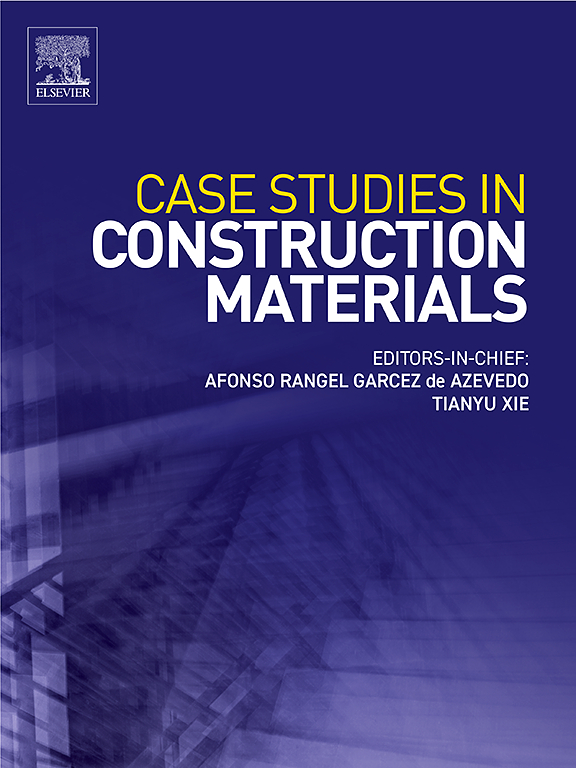Experimental and numerical studies on the impact resistance of reinforced concrete-steel liner composite targets subjected to the tube-type missile impact
IF 6.6
2区 工程技术
Q1 CONSTRUCTION & BUILDING TECHNOLOGY
引用次数: 0
Abstract
This study investigates the dynamic response, damage mechanisms and strategies for enhancing the resistance of reinforced concrete-steel liner (RC-SL) composite structures subjected to tube-type missile impacts. Experimental tests were conducted on eight RC-SL specimens with varying configurations using a large-caliber single-stage gas gun. Finite element (FE) models were developed and validated against experimental data, accurately predicting displacement, acceleration, and damage patterns, though minor limitations in capturing localized failures were noted. The study identified characteristic damage patterns of RC-SL composite structures, including front-side craters, rear-face spalling, tensile tearing, bulging, and localized buckling. Design optimizations, such as rear-mounted steel liners and welded stud-rebar mesh, were found to enhance energy dissipation and interfacial load transfer. The validated finite element (FE) model was utilized to evaluate the safety of a 1.6 × 105 m³ LNG storage tank dome under industry-standard missile impact scenarios. The analysis confirmed that a 400 mm-thick dome sustains only localized damage, with penetration depths varying between 30 and 160 mm, surface crater diameters ranging from 10 to 50 mm, and rear collapse area diameters spanning from 500 to 900 mm. These results demonstrate that the dome maintains both structural integrity and air tightness under such threats. The research conclusions and analytical methods establish a robust foundational framework for the design and failure analysis of RC-SL protective structures, enhancing the reliability of engineering applications.
钢筋混凝土-钢衬板复合靶在管式导弹冲击下的抗冲击性能试验与数值研究
本文研究了钢筋混凝土-钢衬板(RC-SL)复合结构在筒型导弹冲击下的动力响应、损伤机制和增强抗力的策略。采用大口径单级气枪对8个不同配置的RC-SL试样进行了实验测试。有限元(FE)模型的开发和实验数据的验证,准确地预测位移、加速度和损伤模式,尽管在捕获局部故障方面存在一些小的局限性。该研究确定了RC-SL复合材料结构的特征损伤模式,包括前部弹坑、背面剥落、拉伸撕裂、胀形和局部屈曲。设计优化,如后置钢衬垫和焊接螺柱-钢筋网,发现提高能量耗散和界面荷载传递。利用验证的有限元模型对工业标准导弹冲击情景下的1.6 × 105 m³LNG储罐穹窿进行了安全性评估。分析证实,400毫米厚的圆顶只遭受局部损伤,穿透深度在30 ~ 160 mm之间,表面陨石坑直径在10 ~ 50 mm之间,后方塌陷区直径在500 ~ 900 mm之间。这些结果表明,在这种威胁下,穹顶保持了结构的完整性和气密性。研究结论和分析方法为RC-SL防护结构的设计和失效分析奠定了坚实的基础框架,提高了工程应用的可靠性。
本文章由计算机程序翻译,如有差异,请以英文原文为准。
求助全文
约1分钟内获得全文
求助全文
来源期刊

Case Studies in Construction Materials
Multiple-
CiteScore
7.60
自引率
19.40%
发文量
842
审稿时长
63 days
期刊介绍:
Case Studies in Construction Materials provides a forum for the rapid publication of short, structured Case Studies on construction materials. In addition, the journal also publishes related Short Communications, Full length research article and Comprehensive review papers (by invitation).
The journal will provide an essential compendium of case studies for practicing engineers, designers, researchers and other practitioners who are interested in all aspects construction materials. The journal will publish new and novel case studies, but will also provide a forum for the publication of high quality descriptions of classic construction material problems and solutions.
 求助内容:
求助内容: 应助结果提醒方式:
应助结果提醒方式:


